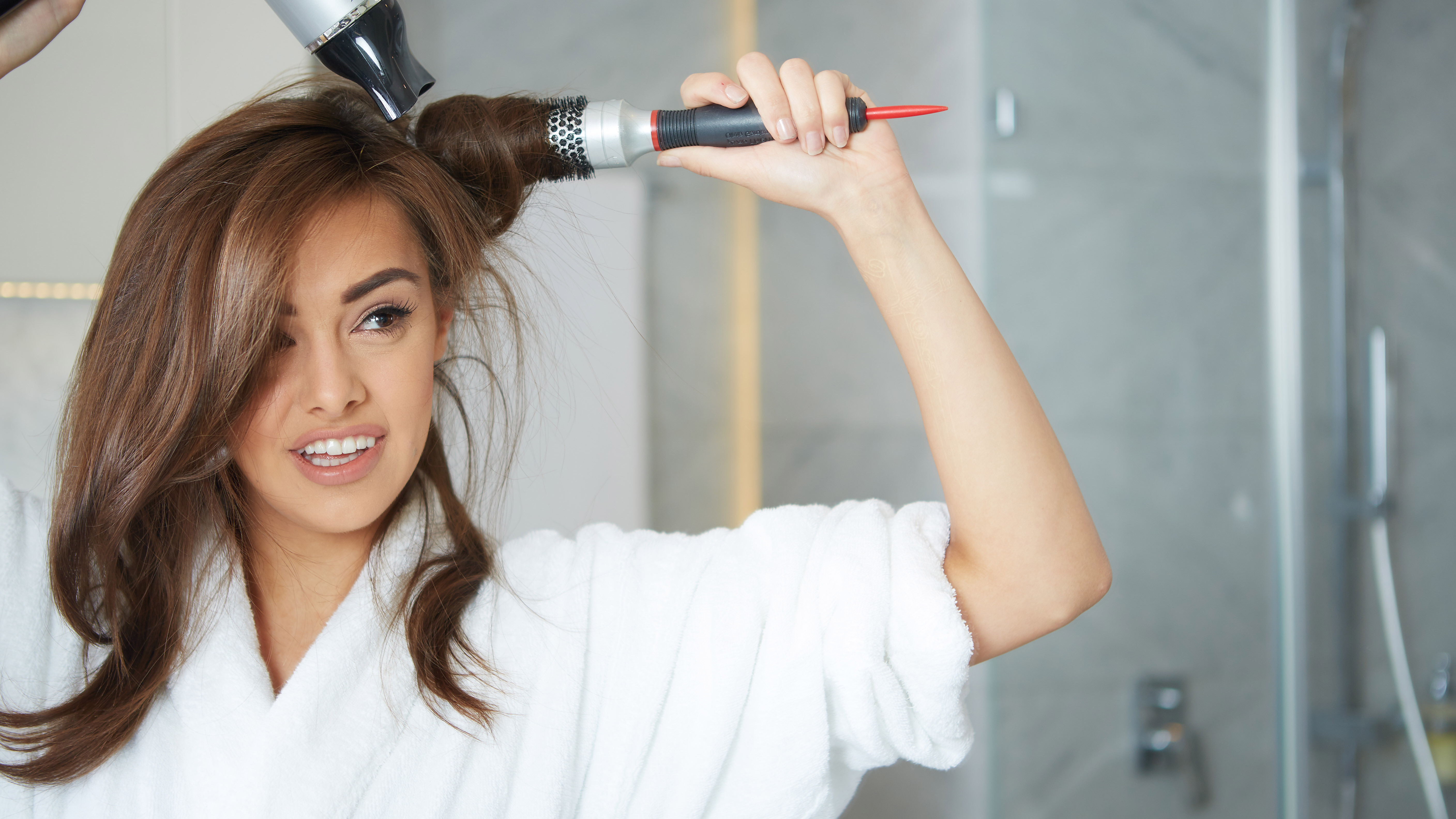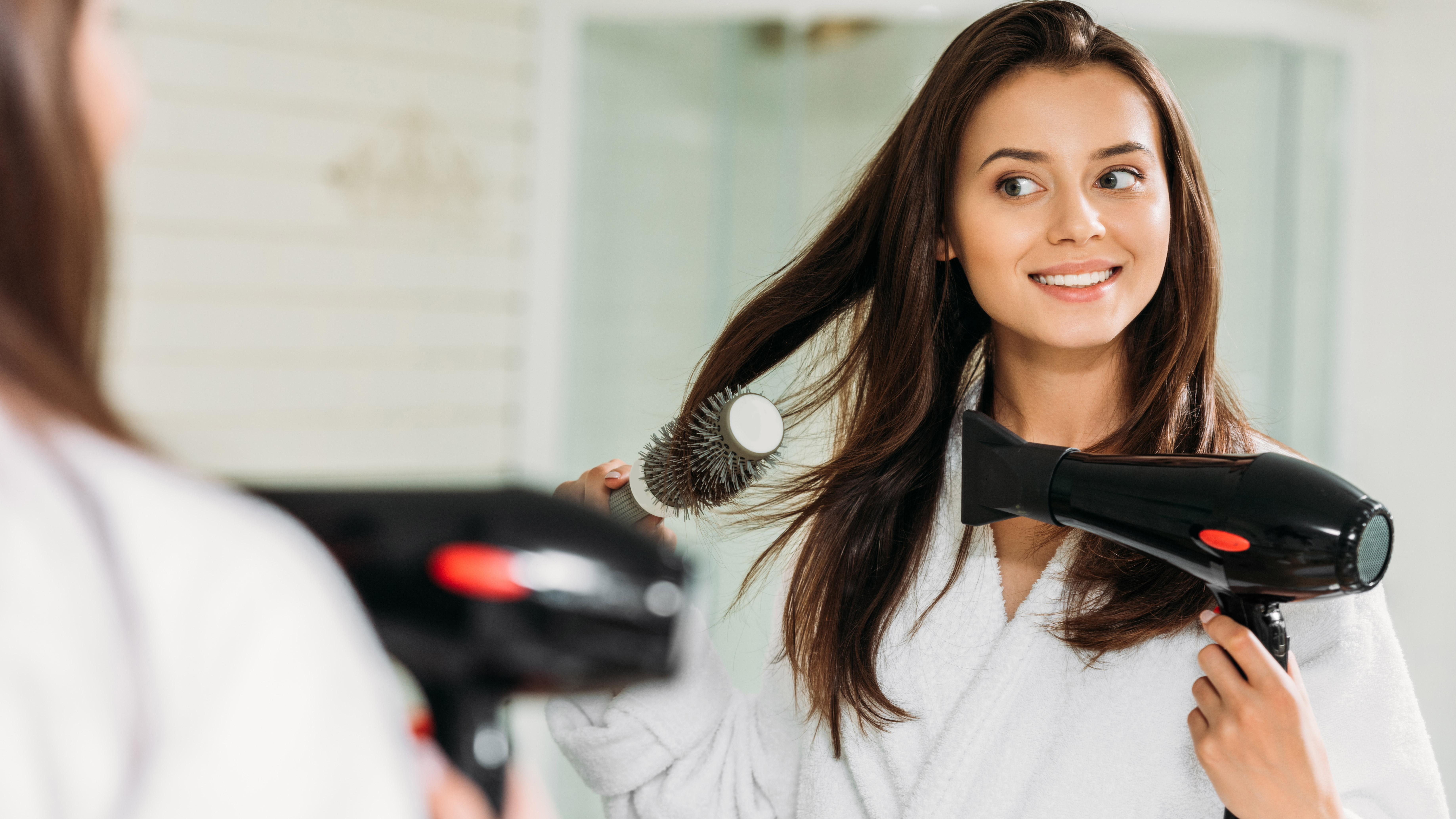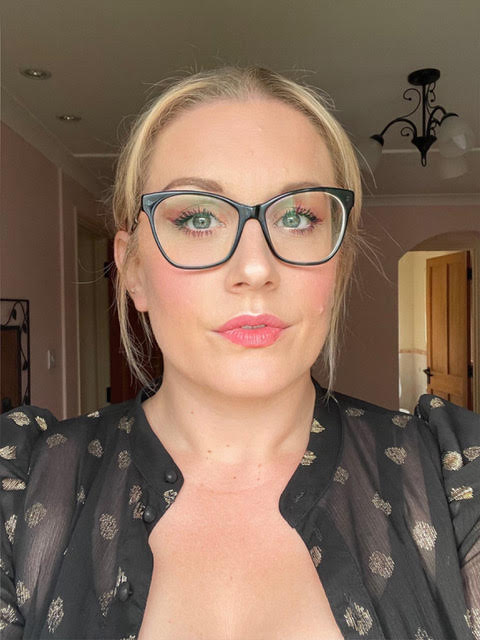What causes heat damage to hair and why you should care
Heat styling is convenient but certainly not kind to your locks

Using appliances to dry and style hair has been commonplace for the past century, but using heat to manipulate your locks into style can actually damage hair. Judging by the rising trend for heatless hair styling tips on TikTok, many of us are looking for ways to ditch our reliance on straighteners, curling irons, tongs and hot wands.
But do you really need to ditch hair dryers, hair straighteners, and other hot styling tools completely? More and more hair care appliances hitting the market can be used at temperatures lower than ever before, including the new version of the Dyson Airwrap, which was unveiled this week. Unlike the original Dyson Airwrap, it has three rather than four temperature settings and it's likely it doesn't reach the same level of heat.
Just like the previous version, the latest version of the Airwrap regulates the hot air it blasts at your hair so it never exceeds 302 F / 150 C. Dyson claims far less heat damage is caused at this temperature.
But what exactly does heat damage do to your hair and aside from ditching electrical hair care appliances, is there a way to repair current damage and prevent it in the future?
Best hair care appliance deals
Read on to find out what heat damage actually is and how you can protect your tresses against it. Alternatively, check out the prices we've found for some of the best hair dryers and hair straighteners right now.
What is heat damage?
“To put it in its simplest form, excessive heat changes the structure of the hair by weakening the bonds in the hair, causing loss in elasticity,” former British hairdresser of the year and founder of hair care range the Hair Boss, Lisa Shepherd told TechRadar.
Every strand of hair on our body consists of a substance known as keratin. Keratin is a complex protein that works by smoothing the outer layer of our hair, called the hair cuticle. This is what leaves hair looking and feeling strong and healthy. Keratin’s complex structures are then held together by different types of bonds. The most important of which, when it comes to heat damage, are hydrogen bonds.
Sign up for breaking news, reviews, opinion, top tech deals, and more.
Hydrogen bonds help control the shape of your hair. When you’ve had your hair in a ponytail for hours, the resulting kinks it creates is the result of hydrogen bonds. If your hair dries in a strange shape from being slept on, that’s caused by hydrogen bonds. Hydrogen bonds are what causes your hair to fall flat in the shower, and they’re what allow you to dry and style your hair when you get out.
When you use a heated styler of any kind, the high temperatures break down these hydrogen bonds. This makes the hair more pliable meaning you can mould it into your desired shape. As the hair cools, new hydrogen bonds then form to lock the style in place.
However, in the process of moulding the hair’s shape, the excess heat also strips away the natural oils found in the hair while causing the water molecules that are bound to keratin proteins to evaporate. This combination weakens the hair’s protein structure and leads to cracks in the hair’s cuticle. Not only does this leave the hair looking dry and frizzy, and lead to split ends and tangles, but it makes the hair more vulnerable to further damage. It exposes the inner layers of hair to further damage while allowing more moisture to escape. And the cycle continues.
This also explains why you should never apply hot stylers to wet hair. Wet hair is more fragile because the hydrogen bonds have already broken down meaning the damage from the heat to these bonds and the proteins is multiplied.

What types of heat cause the damage?
Any temperature that breaks down the hydrogen bonds and changes the structure of the proteins in the hair can cause damage. The extent of the damage, however, depends on your hair type, what temperature you're using and for how long.
This structural change only occurs at temperatures of 302 F / 150 C and above. Stylers offering lower temperatures either won’t perform as well as hotter models – if at all – or they will need to be run over the same section of hair multiple times to raise the overall temperature.
Potential damage to the hair increases as the temperature rises. Yet the most damage occurs at 400 F / 200 C and above. At these highest temperatures, you’ll find the styling results are faster but they also cause the cortex and the keratin inside to melt. This causes the cuticle to break down and the hair to snap.
Thicker hair can withstand higher heats than fine, thinner hair but with a couple of exceptions. Curly hair is thicker but naturally drier, so suits lower temperatures, while color-treated and already damaged hair should be styled at lower heats.
The trade-off when looking to buy a hair styler is finding one that is hot enough to style your hair effectively, yet not too hot to damage its inner core. The Dyson Airwrap falls into this category, although it's been extremely hard to get hold of recently. If you can't wait until the new model hits shelves, our article where to buy a Dyson Airwrap will help you get your hands on one right now.
What does heat-damaged hair look like?
Frizz – particularly if you don’t normally have frizz or your hair isn’t naturally curly – is usually an early indicator of damaged hair. This is because frizz is caused when the hair’s cuticle is raised, and not smooth.
“Visually, heat-damaged hair can look thin, and in some cases, it can appear to just almost vanish, appearing thicker at the roots and thinning out towards the ends,” continued Shepherd.
“Split ends are a pretty obvious sign of heat damage, too. This could also just be a cause of dry hair but either way, action needs taking!”
Heat damage can also make hair look dry and brittle, and it can be dull. The heat damage can even make your hair discolored, so you always want to be careful, particularly if your hair is colored. You could also notice more tangles and knots in the hair and often the hair can look like it has bubbles in it and split from the bottoms and mid-lengths.”
Elsewhere, damaged hair can feel stringy when wet. And when styling heat-damaged hair, you may notice it doesn’t hold its style as well as it used to.
“Curls dropping easily are a sure tell-tale sign that the structure of the hair has been compromised and, therefore, needs building back up,” added Shepherd.

Do hair dryers cause as much damage as stylers?
Any heat applied to the hair does run the risk of causing damage, however, hair dryers are seen as gentler alternatives because of how the heat moves through the hair.
As Shepherd explained: “When you blow dry, heat is constantly moving so it never gets too hot in one place. Whereas with any heated tool, the heat is concentrated.”
What’s more, hair dryers don’t apply heat directly to the hair, so the effect is lessened. With hot stylers, the heat comes into direct contact with each hair strand, often multiple times.
“Using a heated tool is fine if you’re only going over the section of hair once,” Shepherd continued, “But what I often see is when someone uses a straightening iron over the same section multiple times – this can and will cause irreversible damage.
Finally, make sure that you allow your hair to cool down after drying it, but before styling. This allows the hydrogen bonds to reform before you break them down again, thus reducing the potential impact.
How can you protect your hair from heat damage?
When it comes to heat-damaged hair, prevention is better than cure and this starts by applying a heat-protecting spray before using any heated styling tools.
The best heat protectants work by wrapping themselves around the outer layer of the hair and acting like a barrier between the heat and the individual strands. As we explain in our guide on how to straighten your hair, these should be used before styling and should ideally be used alongside a leave-in conditioner.
Applying weekly hair masks and deep conditioning treatments will help your hair recover from daily wear and tear. You should also avoid using hair dryers and heat stylers every day in order to give your hair a rest.
If your hair dryer and/or styler offers a choice of heat settings, always opt for the lowest setting and work your way up. This is particularly true for hair dryers, unless you have thick or unruly hair, spending a little longer drying your hair on a lower setting will make a world of difference to its condition.
And finally, if you have the budget to do so, try to avoid cheap stylers. “Cheap heated tools are most often the issue when it comes to heat-damaged hair,” said Shepherd. “People often wonder why the premium, luxury tool brands are expensive, but it’s because they’re developed and regulated at the correct heat output.
“Same as hair wavers and curling wands, there’s a current trend of mermaid wavers that are all over social media. They’re all on huge discounts and super cheap. It sounds like a great deal, but they are this price because they quite literally fry the hair.”

Can heat damage be reversed?
Heat damage to hair cannot be reversed.
You can use products that superficially improve its appearance and add moisture but once the hair itself is damaged, the only cure is cutting off the damaged sections and starting again.
“When hair is split or brittle, or loses elasticity, the only way to truly repair it at that stage would be to cut that part of the hair off,” continued Koniak. “If you need to rejuvenate or maintain hair, the best way is to have regular hair treatments and try to dry your hair as naturally as possible to avoid any forced heat onto the hair.”
- Check out these great Dyson Airwrap Styler sales and deals

Victoria Woollaston-Webber is a freelance journalist, editor, and founder of science-led health, beauty, and grooming sites, mamabella and MBman. She has more than a decade of experience in both online and print journalism, having written about tech and gadgets since day one for national papers, magazines, and global brands. Victoria specializes in beauty gadgets, as well as small appliances including vacuum cleaners, air fryers, blenders, and mixers, plus all things baby and toddler. When she’s not testing the latest must-have beauty product, she loves Lego Architecture, murder mysteries, and chasing after her four-year-old.